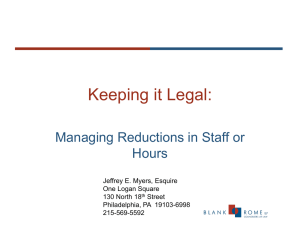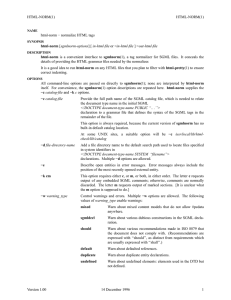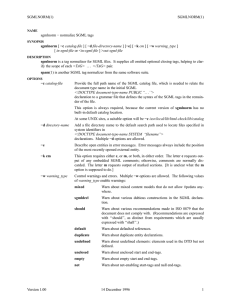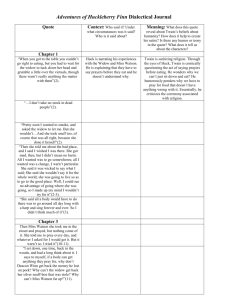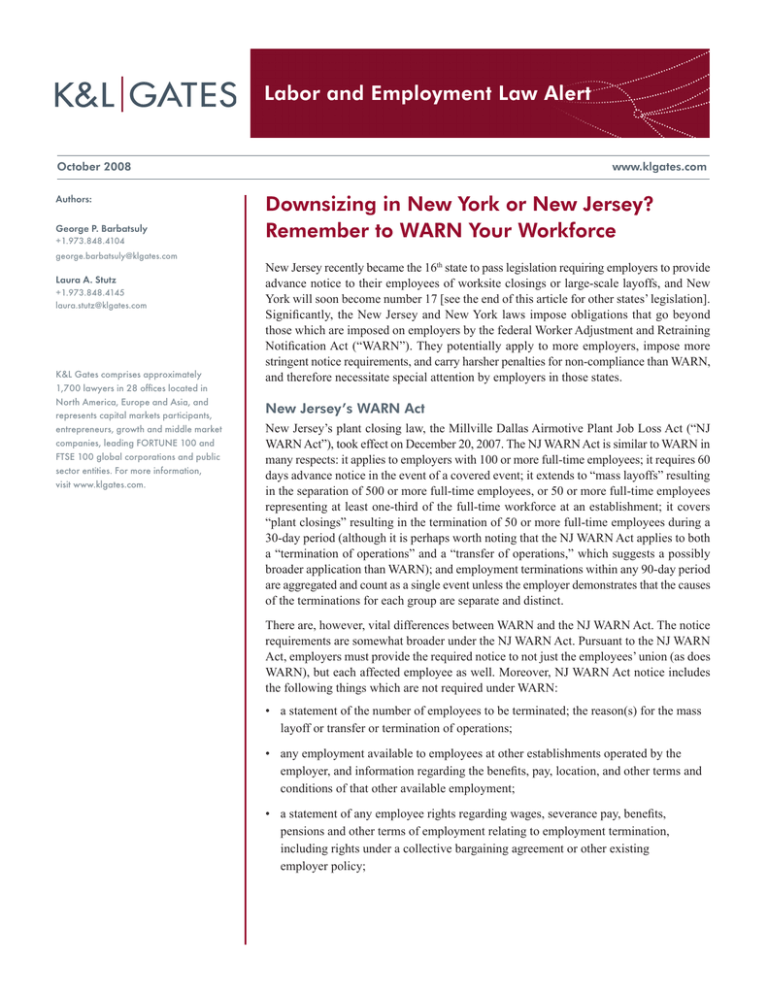
Labor and Employment Law Alert
October 2008
Authors:
George P. Barbatsuly
+1.973.848.4104
george.barbatsuly@klgates.com
Laura A. Stutz
+1.973.848.4145
laura.stutz@klgates.com
K&L Gates comprises approximately
1,700 lawyers in 28 offices located in
North America, Europe and Asia, and
represents capital markets participants,
entrepreneurs, growth and middle market
companies, leading FORTUNE 100 and
FTSE 100 global corporations and public
sector entities. For more information,
visit www.klgates.com.
www.klgates.com
Downsizing in New York or New Jersey?
Remember to WARN Your Workforce
New Jersey recently became the 16th state to pass legislation requiring employers to provide
advance notice to their employees of worksite closings or large-scale layoffs, and New
York will soon become number 17 [see the end of this article for other states’ legislation].
Significantly, the New Jersey and New York laws impose obligations that go beyond
those which are imposed on employers by the federal Worker Adjustment and Retraining
Notification Act (“WARN”). They potentially apply to more employers, impose more
stringent notice requirements, and carry harsher penalties for non-compliance than WARN,
and therefore necessitate special attention by employers in those states.
New Jersey’s WARN Act
New Jersey’s plant closing law, the Millville Dallas Airmotive Plant Job Loss Act (“NJ
WARN Act”), took effect on December 20, 2007. The NJ WARN Act is similar to WARN in
many respects: it applies to employers with 100 or more full-time employees; it requires 60
days advance notice in the event of a covered event; it extends to “mass layoffs” resulting
in the separation of 500 or more full-time employees, or 50 or more full-time employees
representing at least one-third of the full-time workforce at an establishment; it covers
“plant closings” resulting in the termination of 50 or more full-time employees during a
30-day period (although it is perhaps worth noting that the NJ WARN Act applies to both
a “termination of operations” and a “transfer of operations,” which suggests a possibly
broader application than WARN); and employment terminations within any 90-day period
are aggregated and count as a single event unless the employer demonstrates that the causes
of the terminations for each group are separate and distinct.
There are, however, vital differences between WARN and the NJ WARN Act. The notice
requirements are somewhat broader under the NJ WARN Act. Pursuant to the NJ WARN
Act, employers must provide the required notice to not just the employees’ union (as does
WARN), but each affected employee as well. Moreover, NJ WARN Act notice includes
the following things which are not required under WARN:
• a statement of the number of employees to be terminated; the reason(s) for the mass
layoff or transfer or termination of operations;
• any employment available to employees at other establishments operated by the
employer, and information regarding the benefits, pay, location, and other terms and
conditions of that other available employment;
•
a statement of any employee rights regarding wages, severance pay, benefits,
pensions and other terms of employment relating to employment termination,
including rights under a collective bargaining agreement or other existing
employer policy;
Labor and Employment Law Alert
• a disclosure of the amount of severance pay that
is payable in the event of the employer’s failure to
provide the requisite 60-days’ notice;
•
and a statement of the employer’s right to receive
information, referral and counseling from the
New Jersey Department of Labor and Workforce
Development’s response team regarding public
programs that may make it possible to delay or
prevent the layoffs, public programs and benefits
to assist employees, and employee rights based
on law.
Importantly, the “faltering company” and “unforeseen
business circumstances” defenses to failure to
provide notice, both available under WARN, are
not incorporated into the NJ WARN Act. Indeed, an
“unforeseen business circumstance” will only excuse
notice under the NJ WARN Act where it causes a layoff
originally planned for six months or less to be extended
beyond six months. Thus, employers for whom the
current economic climate might excuse compliance
with WARN will have to nevertheless comply with the
notice requirements of the NJ WARN Act. Moreover,
the “natural disaster” exception is narrower under the
NJ WARN Act than under WARN and will excuse
notice only in the event of a termination of operations,
and not in the event of a mass layoff or transfer
of operations.
The penalties imposed by the NJ WARN Act also are
potentially more costly than those under WARN. An
employer who fails to provide the required 60-days
notice must pay its employees severance pay equal
to one week of pay for each full year of employment,
in addition to any severance payment provided by
the employer pursuant to a collective bargaining
agreement or other reason. Any back pay provided
to employees in lieu of WARN notice will reduce or
offset the employer’s severance pay obligation under
the NJ WARN Act.
New York WARN Act
On August 5, 2008, New York State enacted its own
WARN Act (“NY WARN Act”). The NY WARN Act,
which is set to take effect on February 1, 2009, will
reach more employers and cover events not covered
by WARN. Whereas WARN applies to employers
with at least 100 full-time employees and imposes a
60-day notice requirement, the NY WARN Act will
apply to employers with as few as 50 employees and
mandates a 90-day notice requirement. Notice will be
triggered under the NY WARN Act in the event of a
plant closing, mass layoff, or relocation that results in
the termination of at least 25 employees representing
at least 33 percent of the workforce, or 250 fulltime employees regardless of workforce percentage.
In contrast, WARN does not apply unless there is
a separation of 500 employees, or 50 employees
comprising 33 percent of the workforce.
Under the NY WARN Act, notice will need to
be provided to affected employees, their labor
representatives, the New York State Department of
Labor and the appropriate local workforce investment
boards. The form of the required notice is the same as
that required by WARN.
Similar to WARN, the NY WARN Act includes
exceptions to the advance notice requirement for
faltering businesses, unforeseen business circumstances,
acts of terrorism or war, completion of projects or
undertakings and strikes and lockouts. Absent an
applicable exception, an employer’s failure to comply
with the notice provisions may result in penalties being
assessed against the employer, including up to 60 days
of back pay and benefits (similar to that available under
WARN), and civil penalties up to $500 for each day the
employer is in violation. The employer may be able to
offset its liability by payments made to the discharged
employees, including any amounts paid as a result
of a violation of federal law. The employer may also
reduce its liability if it can prove that it had reasonable
grounds to believe that its acts or omissions did not
violate the law.
October 2008 | 2
Labor and Employment Law Alert
Conclusion
Employers considering downsizing as a way to
meet the challenges of the current economic climate
must contend with a host of business and legal
considerations. The NJ WARN Act that took effect
on December 20, 2007, and the NY WARN Act that
will become effective on February 1, 2009, have
further complicated the decision-making process for
employers in New Jersey and New York. Downsizing
employers that fail to give proper consideration to both
WARN and either the NJ or NY WARN Act risk claims
by large numbers of separated employees that could
potentially outstrip the cost-savings those employers
had hoped to achieve.
K&L Gates comprises multiple affiliated partnerships: a limited liability partnership with the full name K&L Gates LLP qualified in Delaware and
maintaining offices throughout the U.S., in Berlin, in Beijing (K&L Gates LLP Beijing Representative Office), and in Shanghai (K&L Gates LLP Shanghai
Representative Office); a limited liability partnership (also named K&L Gates LLP) incorporated in England and maintaining our London and Paris
offices; a Taiwan general partnership (K&L Gates) which practices from our Taipei office; and a Hong Kong general partnership (K&L Gates,
Solicitors) which practices from our Hong Kong office. K&L Gates maintains appropriate registrations in the jurisdictions in which its offices are
located. A list of the partners in each entity is available for inspection at any K&L Gates office.
This publication/newsletter is for informational purposes and does not contain or convey legal advice. The information herein should not be used or
relied upon in regard to any particular facts or circumstances without first consulting a lawyer.
Data Protection Act 1998—We may contact you from time to time with information on K&L Gates LLP seminars and with our regular newsletters,
which may be of interest to you. We will not provide your details to any third parties. Please e-mail london@klgates.com if you would prefer not to
receive this information.
©1996-2008 K&L Gates LLP. All Rights Reserved.
October 2008 | 3
Labor and Employment Law Alert
Mini-WARN Acts: Does Your
State Have One?
Sixteen states, with New Jersey being the most recent
addition and New York soon to follow, currently have
laws requiring advance notice to employees or others
in the event of worksite closings or large layoffs. Those
sixteen states with so-called “mini-WARN” acts are:
California, Connecticut, Hawaii, Illinois, Kansas,
Maine, Massachusetts, Michigan, Minnesota, New
Hampshire, New Jersey, Oregon, Rhode Island, South
Carolina, Tennessee and Wisconsin.
These mini-WARN’s vary greatly in scope and effect.
For example, the Michigan and Minnesota laws make
compliance voluntary. Others create only minimal
obligations. Consider New Hampshire, which only
requires that, in layoffs affecting 25 or more employees,
the employer provide a state agency notice within the
same calendar week as the layoff. In South Carolina,
two weeks notice is required in a plant shutdown only if
the employer requires similar notice from employees in
the event of a quit. Oregon’s mini-WARN is triggered
only if the federal WARN Act applies. And Rhode
Island’s plant closing law is more akin to a wage
payment statute: no notice is required, but an employer
that liquidates or merges, sells or moves out of state
must pay final wages within 24 hours of the triggering
event (for employees with at least one year of service,
the employer must also pay holidays, vacations and
insurance benefits within 24 hours).
Still other mini-WARN’s differ more substantively
from the WARN Act. Some unique components of state
plant closing laws relative to federal law include:
California: applies to layoffs involving 50 employees
in facilities with 75 or more employees, but does not
require that one-third of the workforce be affected, like
the WARN Act; also does not recognize the business
circumstances exception.
Connecticut: in the case of plant closings or relocations
to another state, the employer must pay to continue
existing health insurance of terminated employees for
as long as 120 days.
Hawaii: applies to employers with 50 or more employees.
Illinois: similar to the WARN Act, but covers
employers with 75 employees, and applies to mass
layoffs of 25 or more employees constituting 75% of
the workforce.
Kansas: certain employers must apply to the
state secretary of labor for permission to limit or
cease operations.
Maine: applies to all employers, with only WARNlike exception to notice requirement being physical
calamity (but does include other exceptions: a labor
contract providing for severance exists, employee
accepts a job offer at new facility, or the employee is
employed for less than three years).
Massachusetts: employers with 50 or more employees
at a facility must provide notice; the state bills
employers for reemployment assistance it provides
up to a 13-week maximum, which amount is reduced
for every week of advance notice provided by
the employer.
Tennessee: applies to employers with 50 to 99
employees, and to relocations greater than 50 miles, full
or partial closings, workplace modernization, or other
implementations of management policy if resulting in
a workplace reduction of 50 or more employees over
a three-month period.
Wisconsin: covers employers with 50 or more
employees, applies to closings affecting at least 25
employees, and layoffs of 25% of the workforce or 25
employees, whichever is greater.
October 2008 | 4

